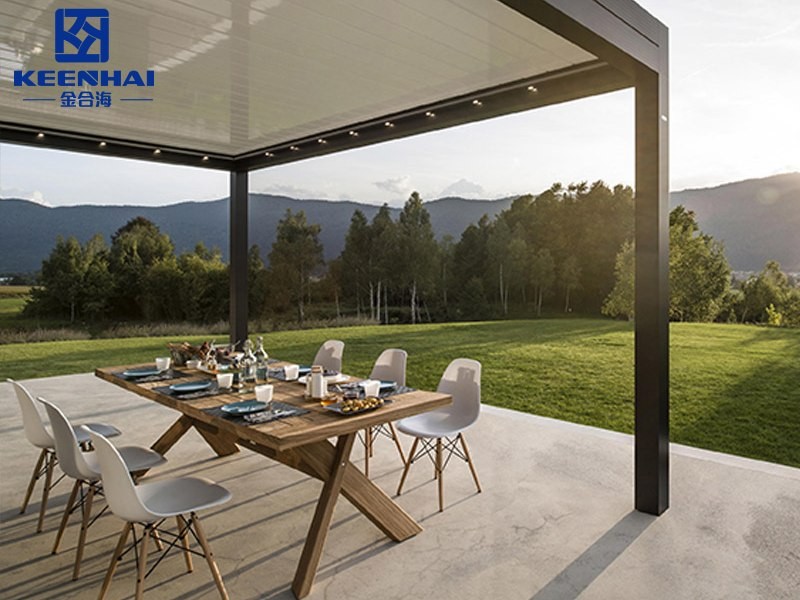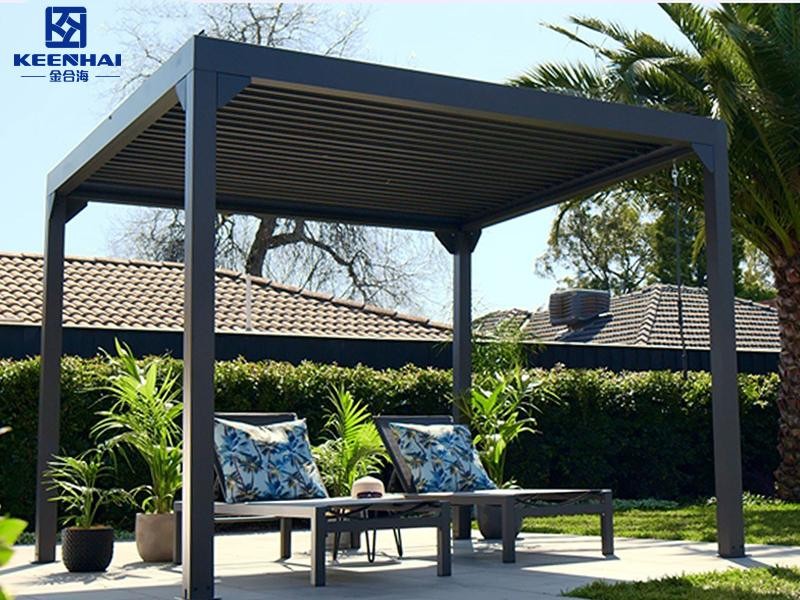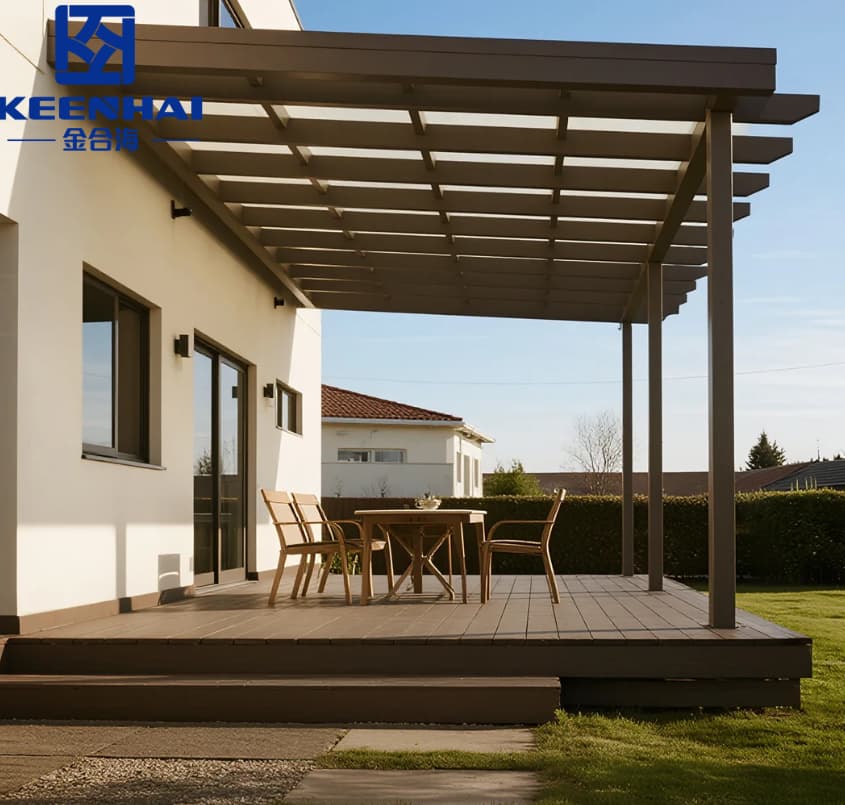
1. Aluminum Pergola Material Costs
When planning an Aluminum Pergola, material choices play a major role in the overall cost. From aluminum grade to roof panels, each decision affects durability, style, and price.
1.1 Aluminum Grade and Alloy Type
Aluminum pergolas typically use 6061 or 6063 alloys, known for strength, corrosion resistance, and lightweight properties. 6061 is stronger, making it ideal for larger structures, while 6063 is commonly used for medium-sized patios. A 12x12 ft backyard pergola in 6061 alloy may cost $250–$400 more than the same size in 6063 due to the added strength and durability.
1.2 Frame Size and Dimensions
Larger pergolas require more aluminum, which directly increases material costs. Here’s a typical size-based cost comparison:
| Pergola Size | Aluminum Required (kg) | Material Cost (USD) |
|---|---|---|
| Small (10x10 ft) | 45–60 | 800–1,200 |
| Medium (12x15 ft) | 70–90 | 1,200–1,600 |
| Large (15x20 ft) | 100–130 | 1,800–2,400 |
For example, a client installed a medium 12x15 ft Aluminum Pergola over a poolside lounge. Using 6063 alloy with a powder-coated finish kept the pergola lightweight yet stable, while maintaining a reasonable budget.
1.3 Roof Style and Panel Options
The roof contributes to both aesthetics and price. Popular options include:
-
Fixed slats – cost-effective and low maintenance.
-
Retractable or adjustable louvers – add $500–$1,500 depending on size.
-
Polycarbonate panels – durable, allow light, and cost slightly more than basic metal panels.
A small backyard pergola with fixed slats may start around $1,200, whereas a medium pergola with polycarbonate panels can exceed $2,000. Choosing the right roof depends on your climate and usage patterns, like shading a patio or covering a pool area.
1.4 Coating and Finish Types
Finishes affect both durability and appearance. Common options include:
-
Powder-coated paint – protects against corrosion and UV damage.
-
Anodized finish – enhances scratch resistance and maintains shine.
-
Custom color coatings – may add $150–$300 depending on size and complexity.
For instance, one homeowner added a powder-coated finish to a medium 12x15 ft Aluminum Pergola. This finish resisted fading even under direct sun exposure, maintaining the modern look for years.
By understanding alloy type, size, roof panels, and coatings, you can realistically plan both budget and design. Every material choice impacts longevity, maintenance, and overall investment.

2. Installation Labor Costs
Understanding labor costs is crucial when budgeting for an Aluminum Pergola. Labor can vary widely depending on professional installation, DIY choices, and regional factors.
2.1 Professional Installation Fees
Hiring a professional ensures proper alignment, secure foundations, and long-term stability. Typical professional fees range based on pergola size and complexity:
-
Small (10x10 ft) – $400–$600
-
Medium (12x15 ft) – $600–$1,000
-
Large (15x20 ft) – $1,000–$1,800
A client in a suburban backyard installed a medium 12x15 ft Aluminum Pergola professionally. The team completed the installation in 1.5 days, ensuring the pergola was perfectly leveled and anchored. Professional labor eliminates common errors like uneven frames or misaligned panels.
2.2 DIY Installation Considerations
DIY installation can save money but requires careful planning and tools. Key steps include:
-
Site preparation – Level the ground and mark footing locations.
-
Foundation setup – Pour concrete footings and allow 24–48 hours to cure.
-
Frame assembly – Connect vertical posts and horizontal beams according to manufacturer instructions.
-
Roof installation – Secure roof panels or louvers, ensuring proper drainage.
DIY savings range from $300–$800, but mistakes in steps 2 or 4 can compromise stability. Homeowners must also consider additional costs for tools or helpers if they lack prior construction experience.
2.3 Labor Cost Variations by Region
Labor rates fluctuate depending on location, demand, and local regulations. Urban areas generally have higher labor costs, while rural regions tend to be cheaper. Here’s a simple comparison:
| Location Type | Average Labor Cost (USD) | Notes |
|---|---|---|
| Urban City | 600–1,200 | Higher wage rates, stricter building codes |
| Suburban | 500–900 | Moderate rates, accessible contractors |
| Rural / Remote | 400–700 | Lower rates, fewer available professionals |
For instance, installing a medium pergola in a city like Chicago may cost $950 in labor, while the same installation in a rural area of Illinois might only be $600. Regional factors also affect material delivery and permit requirements, indirectly influencing labor expenses.

3. Site Preparation Expenses
Proper site preparation is critical for a durable Aluminum Pergola. Skipping steps can lead to uneven frames, water pooling, and long-term damage.
3.1 Ground Leveling and Excavation
The first step is leveling the ground and clearing debris. Typical steps include:
-
Measure and mark the pergola footprint using stakes and string.
-
Excavate soil to create a flat surface, removing rocks, roots, and uneven patches.
-
Compact the soil with a tamper or plate compactor to reduce future settling.
For a 12x15 ft backyard pergola, leveling may take 3–5 hours for two people depending on soil condition. One homeowner leveled a sloped backyard by adding 2–3 inches of compacted gravel, creating a perfectly flat base for their Aluminum Pergola.
3.2 Foundation and Footing Requirements
A strong foundation is key for stability and longevity. Standard footing dimensions are:
| Pergola Size | Footing Depth (inches) | Footing Width (inches) | Notes |
|---|---|---|---|
| Small | 24–30 | 12–16 | Suitable for 10x10 ft pergola |
| Medium | 30–36 | 16–20 | Supports 12x15 ft structures |
| Large | 36–48 | 18–24 | Handles 15x20 ft or larger |
Steps to prepare footings:
-
Dig holes to the specified depth.
-
Install rebar or anchor brackets for structural support.
-
Pour concrete and allow at least 24–48 hours to cure before attaching posts.
A medium-sized pergola installed over a patio used 16-inch wide footings with rebar, ensuring the frame remained secure despite seasonal soil movement.
3.3 Drainage and Soil Stability
Proper drainage prevents water pooling and soil erosion around the pergola base:
-
Grade the site slightly away from the structure (1–2% slope).
-
Install gravel or French drains if the soil retains water.
-
Compact the soil around footings after any rain to prevent settling.
For example, a homeowner in a rainy area added 4 inches of crushed stone beneath their 12x15 ft Aluminum Pergola. This prevented water accumulation and kept the posts from shifting over time. Soil stability measures like this can save significant repair costs in the future.

4. Optional Features and Accessories
Adding optional features can enhance comfort, aesthetics, and usability for an Aluminum Modern Gazebo or pergola, but they also affect the total cost.
4.1 Motorized Louvers and Adjustable Roofs
Motorized louvers let you control sunlight and ventilation with a remote or app. Typical installation involves:
-
Selecting the louver system that fits your pergola dimensions.
-
Wiring the motor to a dedicated electrical source.
-
Testing adjustments to ensure smooth rotation and correct drainage.
Costs vary with size and automation features: a medium 12x15 ft system usually adds $1,000–$1,500 to the base price. A client installed a motorized roof on a poolside 12x15 ft Aluminum Modern Gazebo, allowing them to adjust shade instantly based on sun position or weather, which greatly increased usability.
4.2 Integrated Lighting and Electrical Add-ons
Lighting transforms a pergola into a functional evening space. Options include:
-
LED strips along beams – cost $200–$400.
-
Recessed ceiling lights – cost $300–$600.
-
Outdoor electrical outlets – $100–$250 each.
Steps to integrate lighting:
-
Plan the layout considering power source and coverage.
-
Install wiring safely with waterproof conduits.
-
Mount lights and test functionality.
A backyard entertainment area added LED strips along a 15x20 ft Aluminum Modern Gazebo, creating ambient lighting for evening gatherings without raising electricity costs excessively.
4.3 Side Panels, Curtains, and Shade Accessories
Side panels provide privacy and block wind or sun. Typical options include fabric curtains, tempered glass panels, or polycarbonate inserts. Costs range from $150–$800 depending on materials and size.
| Accessory Type | Material | Typical Cost (USD) | Notes |
|---|---|---|---|
| Curtains | Weather-resistant fabric | 150–400 | Easy to install, removable |
| Glass Panels | Tempered glass | 400–700 | More durable, adds modern aesthetic |
| Polycarbonate Panels | Clear or tinted | 250–800 | Lightweight, blocks UV |
For example, a homeowner added fabric curtains on a medium 12x15 ft Aluminum Modern Gazebo for afternoon shade. The curtains were mounted with tracks for smooth operation, enhancing both comfort and privacy.
5. Size-Based Cost Comparisons
The size of your pergola heavily impacts the total cost, especially when upgrading a backyard or patio into a functional living space. A well-planned Aluminum pergola house balances size, materials, and optional features.
5.1 Small Pergolas (≤10x10 ft)
Small pergolas are ideal for compact patios, balconies, or garden corners. Average costs include:
-
Materials: $800–$1,200
-
Installation: $400–$600
-
Optional features: $150–$500
Example: A homeowner installed a 10x10 ft pergola over a rooftop terrace. Using powder-coated aluminum and a fixed louver roof, the total investment was $1,700, providing a cozy, shaded seating area.
5.2 Medium Pergolas (10x15 ft)
Medium pergolas fit larger patios or backyard entertainment areas. Costs increase with size and optional upgrades:
| Size | Material & Base Features | Optional Add-ons | Total Average Cost (USD) |
|---|---|---|---|
| Medium 12x15 ft | Powder-coated frame, fixed slats | Curtains, polycarbonate panels, LED lighting | 2,200–2,800 |
For instance, a family upgraded their backyard dining area with a 12x15 ft Aluminum pergola house. They added fabric curtains and integrated lighting, turning the space into a comfortable, year-round outdoor room.
5.3 Large Pergolas (≥15x20 ft)
Large pergolas suit expansive patios, poolside areas, or entertainment zones. They require more materials, labor, and planning:
-
Materials & frame: $2,500–$3,500
-
Installation: $1,000–$1,800
-
Premium features: $800–$1,500
Example: A 20x20 ft backyard pergola was installed with polycarbonate panels, motorized louvers, and integrated lighting. The total project cost reached $5,200, providing both functionality and a striking architectural centerpiece for the outdoor space.
By comparing small, medium, and large pergolas, homeowners can align their budget with desired coverage and features, ensuring practical use while enhancing outdoor living.
